Opening
Program  Program
I Program
I  Program
II Program
II  Program
III Program
III  Program
IV Program
IV  Program
V Program
V  Program
VI Program
VI  Program
VII Program
VII  Program
VIII Program
VIII  Program
IX Program
IX  Program
X Program
X  Program
XI Program
XI  Russian
Dance Film Competition Russian
Dance Film Competition  Closing Program
Closing Program

Program
VII, Part 1: Dance Form in Focus: BUTOH
"A Summer Storm by Hijikata
Tatsumi" presented
by the director Arai
Misao in person
"A
Summer Storm by Hijikata Tatsumi: 2003~1973 Hangi-dai-to- kan"
2003,
71min, Japan
Director / Editor: Arai Misao
Choreographer: Tatsumi Hijikata
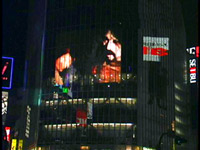
Photo
by Arai
Misao |
“A
Summer Storm by Hijikata Tatsumi”
primarily consists of the legendary Japanese dancer Hijikata
Tatsumi's legendary performance shot in Kyoto in 1973, and is
a tribute to this extraordinary talent. Now, thirty years later,
it is still funny, sad, and infinitely gripping. Hijikata was
the pioneer of the reputed Butoh dance. Butoh, performed in
slow, unique movements by dancers, with their bodies painted
white and bent-forward, is an antithesis of the traditional
Western dance. As the only remaining footage in color of his
performance, the film shows Hijikata as an eternal punker, rebel,
and sufferer.
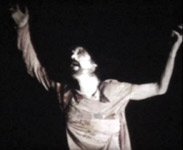 Photo
by Arai
Misao
Photo
by Arai
Misao |
Arai's
filmmaking career started in 1962 as an assistant director at
Toei's film studio in Kyoto after he graduated from Tokyo University.
For the next ten years he worked as a director until he started
working for Toei's Tokyo Head Office. His major works include
the critically acclaimed “The Case of the Missing Co-Ed”.
In 1981, Arai played a key role in the shooting on location in
Kyoto of United Artist's horror film, “The House Where Evil
Dwells”, as its Japanese coordinator. Arai's involvement
with Hijikata started when he promoted the latter's legendary
Kyoto performance, which he filmed into what was later to become
“A Summer Storm by Hijikata Tatsumi”. Arai also promoted
the first Japanese performance of Merce Cunningham & Dance
Company and John Cage in Kyoto in 1976, achieving the record attendance
at the time of 4,000 audience, establishing the company's reputation
in Japan. In 1992, Arai left Toei to start working independently,
and commenced “A Summer Storm by Hijikata Tatsumi”
project.
Program VII, Part 2: Dance Form in Focus: BUTOH
presented by Daniéle Wilmouth
Emerging
in the late 1950s Japan, the dance movement known as Butoh is
one of the nation’s key contributions to the avant-garde.
KINODANCE hosts filmmaker Daniéle
Wilmouth from Chicago, who will screen several
of her own films as well as a curated collection of rarely seen
historical & contemporary Butoh titles.
Daniéle
Wilmouth is
an artist working primarily in experimental and documentary
filmmaking. In 1990 she began a six-year residency in Osaka,
Japan, where she co-founded Hairless Films, an independent filmmaking
collective. For more than 5 years she studied the Japanese contemporary
dance form Butoh with several teachers including Yoshito Ohno,
Min Tanaka, Maro Akaji, Byakko-sha, and her main instructor
Katsura Kan. Her films Curtain of Eyes, Tracing
a Vein, Containers and ROUND have won
awards and screened widely in festivals, museums and on television
around the world. She is currently a faculty member in the film
and video departments of The School of the Art Institute of
Chicago and Columbia College.
Curator's
Statement:
"The
presentaton of this Butoh film screening in Chicago last October,
and now in Russia, is my effort to globalize what has often
been a primarily Western understanding of postwar experimentalism
in dance & film. Defined by Tatsumi Hijikata, Ankoku Butoh
or the ‘Dance of Utter Darkness’ is soon approaching
its 50th anniversary, yet it remains surprisingly under acknowleged
or misunderstood by artists and dancers around the world. The
short films which comprise this screening are extremely rare,
and reveal a thriving Japanese post-war art community, which
grew from a combination of Japanese primitive roots, traditional
performing arts and Western influences such as Expressionist
dance, Surrealism, Dada and Existential thought. Sadly, this
is not a complete retrospective of Butoh dance films, but instead
a modest sampling of prominent titles and key influences. I
have assembled films which both introduce the roots and founders
of Butoh, as well as suggest interdisciplinary fusions of Butoh
with other arts like theater, music, film and poetry. Finally,
the screening includes films made by non-Japanese artists influenced
by Butoh, such as myself, reflecting the current global economy
and shifts in international and cultural artistic exchange."
- Daniéle Wilmouth (October, 2004)
Navel
and A-Bomb 1960, 16mm B&W film, 12 min,
Japan
Director: Hosoe Eikoh
Choreography: Tatsumi Hijikata
Performers: Local villagers and children
Laden
with symbolism, Navel and A-Bomb is a seminal film in Butoh’s
history. Hooded men stand on an empty beach beside a placid
cow. Disembodied hands fight over an apple perched on a
sand volcano. A man emerges from the ocean to pull a long
rope out of the navel of a young boy. Climaxing with an
Atomic mushroom cloud – the film is a surreal and
political spectacle by the sea.
Hosoe Eikoh
is best known as a photographer. He worked extensively with
Tatsumi Hijikata
in the 1960s/70s – taking him and his dancers off
the stage, and placing them in other-worldly cinematic landscapes.
He is currently the director of the Kiyosato Museum of Photography
and a professor at Tokyo Kogei University in Japan.
Curtain
of Eyes 1997,
13 min, 1997, USA/Japan
Director / Editor: Daniéle Wilmouth
Dancers: Okyon, Izuru Mori, Takechiyo Mariya, Lee
Distributor: Hairless Films / Daniéle Wilmouth

Photo
by Kazuya Tachikawa |
"Curtain
of Eyes is an experimental film, which combines
Japanese Butoh dance with psychological imagery and choreographed
cinematography. Over a six month period, I collaborated with
the Kyoto based Butoh dancer Katsura Kan, and his dance company
The Saltimbanques, to create movements for both dancers and
camera. Based on a dream, the film is an exploration of intimate
relationships and bi-cultural identity. It maps a transformation
that I underwent as a European American living in Japanese
culture. The choreography mirrors several stages that I, like
many expatriates experience; An initial period of discovery
and comparison, then a loss of personal identity and virtual
paralysis, and finally an empowering bi cultural outlook and
individuality." - Daniéle Wilmouth
Photo credit: Kazuya Tachikawa
ROUND
11min, 2002, USA
Directors: Daniéle Wilmouth & Hiroshi McDonald
Mori
Performers: Joseph Ravens & Alyssa Miserendino
Distributors: Daniéle Wilmouth & Hiroshi McDonald
Mori
 Photo
by Daniele Wilmouth
Photo
by Daniele Wilmouth |
"ROUND
is a research project on analogue & digital myths of creation.
In consultation with scientists, folklorists & theologians,
we study the sterile white digital world of replication; a
virtual breeding farm. Turbulent floods and disembodied hands
sculpt figures with uncertain identities. Bodies roll chasing
their own shadows in an infinite stream; a human race - questioning
the danger - or benefit - of becoming a thing amongst the
things we produce." - Daniéle Wilmouth
Photo credit: Daniele Wilmouth & Hiroshi McDonald Mori
Tracing
a Vein 15min, 2001, USA
Director / Editor: Daniéle Wilmouth
Dancers: Joseph Ravens, Adrian Danzig, Katherine Behar, Marianne
M. Kim
Distributor: Hairless Films / Daniéle Wilmouth
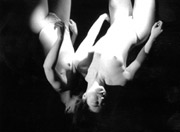
Photo
by Mayumi Lake & Lina Hoshino |
"A
contemporary ceremonial dance between performers and camera,
Tracing a Vein combines live action and stop motion
cinematography. The title Tracing a Vein refers
to reconnecting with one's origins, and communion with one’s
ancestors. Fire is used to symbolize destruction, purification,
and a conclusion which nourishes a new beginning. Ancient
ceremonial costumes are given a contemporary translation;
traditional materials like feathers and bark are replaced
by common clothespins, making the body into a tactile tapestry.
Influenced by Japanese Butoh dance, the choreography draws
on a range of mythology and folklore to re-appropriate the
sacred power & possibilities of ancient performance;
to rediscover the performer as priest, warrior and healer."
- Daniéle Wilmouth
FASTENERS
8.5min, 2004, USA
Director / Editor: Marianne M. Kim
Performers: Katherine Behar & Marianne M. Kim
Distributor: Marianne M. Kim
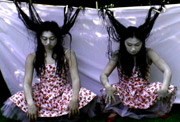 Photo
by Marianne M. Kim & Lee Anne Schmitt
Photo
by Marianne M. Kim & Lee Anne Schmitt |
FASTENERS
is a portrait of a single female split in two, moving in and
out of memory, fantasy, and isolation. It is an experimental
performance video inspired by the movement of Japanese Butoh
and the writings of Elias Cannetti. FASTENERS references the
phenomena of twin like behavior within the confines of imagined
role-playing. The twins in the video conjure roles of lovers,
sisters, and a mother/child struggling with their ambivalence
to attach or detach. The concept of reflection is literally
and metaphorically used as memory and the portrait of a single
“She” split in two.
Movement/video
artist Marianne M. Kim
is critically acclaimed for her independent work, as well
as past collaborations with awarding winning XSIGHT! Performance
Group. Her most recent performance and video projects have
been presented at University of Alaska Anchorage through
the NEA/DanceUSA, Bunnell Gallery in Homer Alaska, The Art
Institute of Chicago's Betty Rymer Gallery, University of
Illinois at Weselyn and Atlanta's ‘Seen + Heard’
Festival. Kim is a recipient of fellowships from Illinois
Arts Council, Jacob K. Javits Foundation, and several grants
from the Chicago Artists Assistance Grants to create new
work. She received Chicago’s Ruth Page Award for Choreography
and Performance in 1999, and was nominated for a 2002 Lester
Horton Award for Short Form Choreography. This year she
will be in residence at The Chicago Cultural Center, ARGE
in Salzburg, and the University of Wisconsin/Madison.
Lament
10min,1986, USA
Directors: Eiko & Koma and James Byrne
Sound mix: Eiko & Koma
Lament
Lament is an elusive intimate meditation on organic landscapes
and biomorphic forms, which redefine the shape and nature
of the human body. In a stage set entirely in water, the
dancers perform in unison with their rippling reflections.
Water is one of Eiko and Koma’s strong motifs. Water
is in our bodies, rivers, seas, our wombs, and our tears.
The movement material was adapted from Eiko & Koma's
1984 performance work Elegy.
Undertow
8min,
1988, USA
Directors: Eiko & Koma
Music: Ushio Torikai
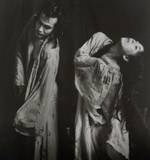
Photo
by Marcus Leatherdale |
Eiko’s
notes on Undertow:
"We wanted to find unconventional camera positions, which
would dramatically contribute to the content of the work.
We decided James should be on a ladder and sway above us.
We cut the side light sharply at knee height to create blackness
from which Koma and I emerge, and into which we sink back.
We used the shortcomings of video, the fact that a camera
cannot see what humans can see, to our advantage. The result
was the unsettling Undertow, in which the camera-eye and all
subjects sway. The piece floated in both space and time as
if coming from and going back into a void."
Eiko's note
on video:
Early on, we understood that in order to be effective, we
needed to
choreograph dance specifically for the camera. Realizing that
film/video
are inherently flat, while dance is three-dimensional, we
looked for ways to
make a composition emphasizing depth...we hope to bring to
film the similar
sense of shared endurance, where an audience is personally
involved and
hopefully feels invested and rewarded."
Since
1971, the contemporary performance team Eiko
& Koma have been choreographing pieces
for stage, screen and landscape throughout the world. Eiko
& Koma were born in Japan and studied with two of the
founders of Butoh, Tatsumi Hijikata and Kazuo Ohno. They
also studied with Manja Chmiel, a disciple of Mary Wigman,
a pioneer of German Expressionist dance. Eiko & Koma
not only work between the disciplines of dance & film,
but they also create works on the boundary between live
performance & installation, treating bodies as a part
of a larger landscape. Eiko & Koma have been permanent
residents of the United States since 1976. They currently
live in New York City. Eiko & Koma were named MacArthur
Fellows in 1996, and were presented the 2004 Samuel H. Scripps
/ American Dance Festival Award for lifetime contribution
to the field of American modern dance. Visit Eiko &
Koma’s website: www.eikoandkoma.org.
Mr.
O’s Trilogy 1969 – 1975,
5 minute excerpt , Japan
Director: Chiaki Nagano
Dancer: Kazuo Ohno
Distributor: Kazuo Ohno Dance Studio
http://www.asahi-net.or.jp/~ab4t-mzht/index.html
Mr.
O’s Trilogy consists of short excerpts from the following
three films: The Portrait of Mr. O (1969), The Mandala of
Mr. O (1973), Mr. O’s Book of the Dead (1975). They
were produced by Ohno and Nagano themselves between the
years of 1969 to 1975. Kazuo
Ohno worked with Tatsumi Hijikata in the
60s but suddenly stopped appearing on stage after 1968.
Then, he was devoted to making films with Chiaki Nagano.
The films focus on Ohno’s improvisational performances
and are full of the sensations of the Japanese avant-garde
art movement at the time.
Chiaki
Nagano was born in 1931 in Yokohama, Nagano
was active as a freelance filmmaker from the 60s through
the 70s. After meeting with Kazuo Ohno, he made Mr. O’s
Trilogy, and later a documentary on Yoko Ono.
KAZUO
OHNO 14 minutes, 1995, Japan
Director: Daniel Schmid
Dancer: Kazuo Ohno
Distributor: Kazuo Ohno Dance Studio
http://www.asahi-net.or.jp/~ab4t-mzht/index.html
Featuring
Kazuo Ohno and his wife, Chie Ohno. Presented by Aichi Arts
Center as a program of Aichi Prefectural Arts Promotion
Service. Originally, the footage of Ohno by Schmid was part
of the film The Written Face, featuring Bando Tamasaburo.
A short section was later independently produced from the
footage, resulting in the poetic short film KAZUO OHNO.
Daniel
Schmid was born in 1941 in Switzerland,
Schmid Founded Tango Film Productions with Fassbinder in
1965. His filmography includes La Paloma (1974), Il Bacio
Di Tosca (1984) and The Written Face (1995).
O, Kind God! 79 minutes (excerpt),
2003, Japan
Director: Gianni di Capua
Dancers: Kazuo Ohno & Yoshito Ohno
Distributor: Kazuo Ohno Dance Studio
http://www.asahi-net.or.jp/~ab4t-mzht/index.html
After
around 2000, Kazuo Ohno has been living with Alzheimer’s
Disease and has had difficulty walking. Ohno’s strong
desire to dance has not diminished however . The piece is
a documentary about Ohno’s life and art, emphasizing
his overwhelming gestures and emotions.
Gianni di Capua
is active as a freelance filmmaker in Italy. He is known
for his biographical documentary on Luigi Nono. He currently
teaches the History of Documentary Filmmaking at Venice
University.
For further information about Kazuo Ohno, or to purchase
videos, please visit the official Kazuo Ohno Dance Studio
website:
http://www.asahi-net.or.jp/~ab4t-mzht/index.html
|
|

